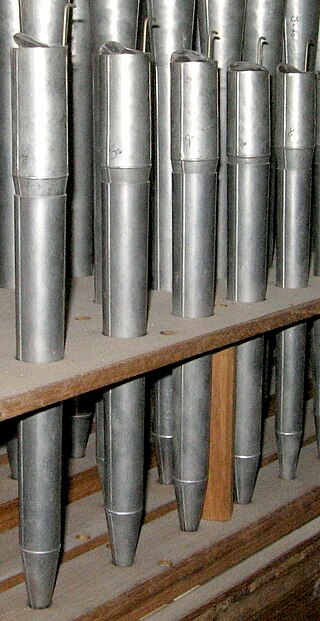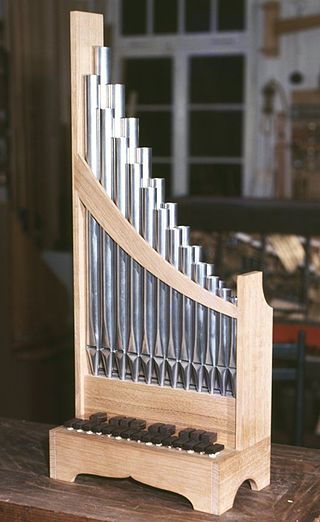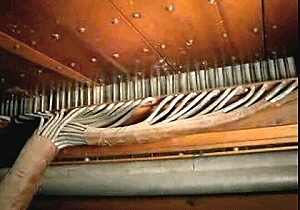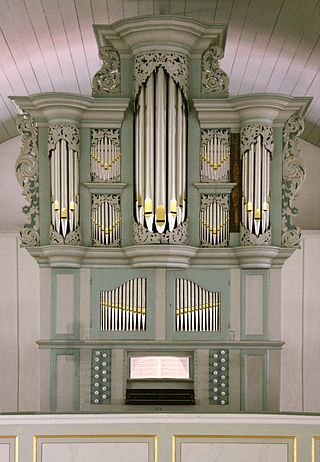
The pipe organ is a musical instrument that produces sound by driving pressurised air through the organ pipes selected from a keyboard. Because each pipe produces a single pitch, the pipes are provided in sets called ranks, each of which has a common timbre, volume, and construction throughout the keyboard compass. Most organs have many ranks of pipes of differing pitch, timbre, and volume that the player can employ singly or in combination through the use of controls called stops.

In music, the organ is a keyboard instrument of one or more pipe divisions or other means for producing tones. The organs have usually two or three, up to five, manuals for playing with the hands and a pedalboard for playing with the feet. With the use of registers, several groups of pipes can be connected to one manual.

The vox humana is a short-resonator reed stop on the pipe organ, so named because of its supposed resemblance to the human voice. As a rule, the stop is used with a tremulant, which undulates the wind supply, causing a vibrato effect. The vox humana is intended to evoke the impression of a singing choir or soloist, though the success of this intent depends as much upon the acoustics of the room in which the organ speaks as it does the voicing of the pipes. It is almost invariably at 8 ft pitch, though on theater organs it is not uncommon to encounter a chorus of vox humana stops unified at 16 ft, 8 ft and occasionally 4 ft pitch on the Great manual and 8 ft and 4 ft pitch on the Accompaniment manual.

An organ stop is a component of a pipe organ that admits pressurized air to a set of organ pipes. Its name comes from the fact that stops can be used selectively by the organist; each can be "on", or "off".

A pedalboard is a keyboard played with the feet that is usually used to produce the low-pitched bass line of a piece of music. A pedalboard has long, narrow lever-style keys laid out in the same semitone scalar pattern as a manual keyboard, with longer keys for C, D, E, F, G, A, and B, and shorter, raised keys for C♯, D♯, F♯, G♯ and A♯. Training in pedal technique is part of standard organ pedagogy in church music and art music.

The water organ or hydraulic organ is a type of pipe organ blown by air, where the power source pushing the air is derived by water from a natural source or by a manual pump. Consequently, the water organ lacks a bellows, blower, or compressor.

A flue pipe is an organ pipe that produces sound through the vibration of air molecules, in the same manner as a recorder or a whistle, in a pipe organ. Air under pressure is driven through a flue and against a sharp lip called a labium, causing the column of air in the pipe to resonate at a frequency determined by the pipe length. Thus, there are no moving parts in a flue pipe. This is in contrast to reed pipes, whose sound is driven by beating reeds, as in a clarinet.

Tracker action is a term used in reference to pipe organs and steam calliopes to indicate a mechanical linkage between keys or pedals pressed by the organist and the valve that allows air to flow into pipe(s) of the corresponding note. This is in contrast to "direct electric action" and "electro-pneumatic action", which connect the key to the valve through an electrical link or an electrically assisted pneumatic system respectively, or "tubular-pneumatic action" which utilizes a change of pressure within lead tubing which connects the key to the valve pneumatic.

An expression pedal is an important control found on many musical instruments including organs, electronic keyboards, and pedal steel guitar. The musician uses the pedal to control different aspects of the sound, commonly volume. Separate expression pedals can often be added to a guitar amplifier or effects unit and used to control many different aspects of the tone.

A portative organ, also known during Italian Trecento as the organetto, is a small pipe organ that consists of one rank of flue pipes, sometimes arranged in two rows, to be played while strapped to the performer at a right angle. The performer manipulates the bellows with one hand and fingers the keys with the other. The portative organ lacks a reservoir to retain a supply of wind, thus it will only produce sound while the bellows are being operated. The instrument was commonly used in European secular music from the 12th to the 16th centuries.
The electro-pneumatic action is a control system by the mean of air pressure for pipe organs, whereby air pressure, controlled by an electric current and operated by the keys of an organ console, opens and closes valves within wind chests, allowing the pipes to speak. This system also allows the console to be physically detached from the organ itself. The only connection was via an electrical cable from the console to the relay, with some early organ consoles utilizing a separate wind supply to operate combination pistons.

The Boardwalk Hall Auditorium Organ, known also as the Midmer-Losh and the Poseidon, is the pipe organ in the Main Auditorium of the Boardwalk Hall in Atlantic City, New Jersey, built by the Midmer-Losh Organ Company. It is the largest organ in the world, as measured by the number of pipes.
This article describes the process and techniques involved in the tuning of a pipe organ. Electronic organs typically do not require tuning.

The gourd mouth organ is a free reed mouth organ played across East and Southeast Asia. It consists of a gourd wind chest with several bamboo or bronze pipes inserted on top of it, the numbers of pipes differing from region to region.

"Tubular-pneumatic action" refers to an apparatus used in many pipe organs built during the late 19th and early 20th centuries. The term "tubular" refers to the extensive use of lead tubing to connect the organ's console to the valves that control the delivery of "wind" to the organ's pipes. Many such organs are extant 100 or more years after their construction.

The Jacobikerk organ in Uithuizen in the Dutch province of Groningen was built in 1701 by Arp Schnitger. It has 28 stops which are distributed on two manuals and pedal. The instrument is one of the best preserved Schnitger organs. The organ has been used as a template for newly built organs in the 20th century and for the reconstruction of lost stops of other Schnitger organs.

The organ of the Dorpskerk in Noordbroek in the Dutch province of Groningen was first built in 1696 by Arp Schnitger. Today it has 24 stops over two manuals and pedal. The case and the disposition are largely preserved as they were in 1809.

The organ of St. Ludgeri in Norden was built from 1686 to 1692 by Arp Schnitger. It has 46 stops, five divisions, three manuals and pedal, and is thus the second-largest surviving Schnitger organ in Germany and until 2018 the largest organ in East Frisia. Historically and musically it is considered an art-work of international rank.

The organ of the Grasberg church, or Findorffkirche, in Grasberg was built in 1693–1694 by Arp Schnitger, originally for the orphanage at Rödingsmarkt in Hamburg, and transferred to Grasberg in 1788. It is one of the few instruments by Schnitger to have been structurally changed as early as the 18th century. The organ has 21 stops, over two manuals and pedal. 15 stops are still original Schnitger work.

The organ of the St. Pankratius in Hamburg-Neuenfelde was built in 1688 by Arp Schnitger, and is his largest two-manual organ. The instrument has 34 stops, of which about half are original. Neuenfelde itself belongs to the Altes Land and was incorporated to Hamburg in 1937.





















